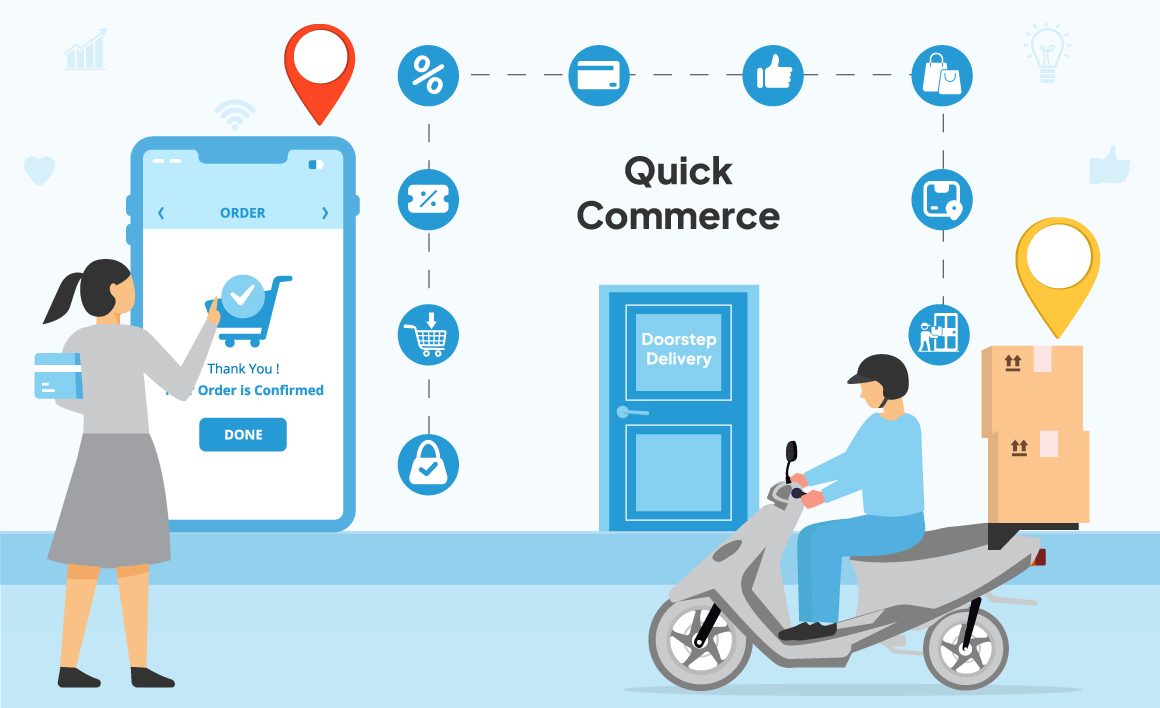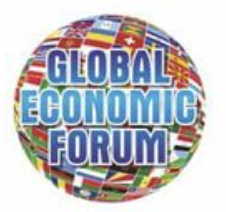Research Objectives
Explore the strategies employed by organized retailers to capitalize on market opportunities and address challenges within the retail sector. Investigate potential avenues for organized retailers to navigate the retail market successfully. Assess the feasibility of enhancing India’s retail landscape by fostering collaboration between organized and unorganized retailers, as well as e-tailers.
Bio
Dr. Hari Krishna Maram, Founder Chairman of Global Economic Forum, Digital Brand Ambassador, Chairman of Vision Digital India & Founder Chairman of Imperial College and Vice Chancellor of Global Digital University, USA. Dr. Maram’s work in the field of Management and Management Education spans over 28 years. Worked for a decade in leading MNC Novartis Global Pharma. He has an illustrious career in education and has served as the Governing Council Member at AIMA, Chairperson – the International Facility Management Association (IFMA), and Vice President at AIMS. President Led India Foundation USA, Served in Lions International 20 Years in Different Capacity instrumental in building Lions Super Speciality Hospital of 7 Crore and Chairperson Higher Education Forum –Karnataka amongst many other designations. His efforts in management education have been recognised on numerous occasions by the Government of India. He is also a part of the UGC Committee.
Keywords
Organized retailers, Unorganized retailers, Etailers, Multichannel buying, Leverage integrated efforts.
Abstract
Growing consumerism calls for all types of retailers to deliver quality product/service offerings and differentiated experiences in line to consumers’ needs and preferences. Tech savvy consumers of today are engaged in multichannel buying behaviour and are not loyal to any particular format. Unorganized retailers are redoing their outlets to match competition and organized retailers (including e-tailers) are stretching themselves-all in an effort to offer consumers the ‘differential experience’. The Indian retail market poses tremendous challenges for all retailers, so instead of competing with each other it is felt that leveraging integrated efforts would be more beneficial.
However, this will be very challenging with all retailers required to structure their internal and external processes with suitable technological and physical infrastructure so as to be able to understand both clicks (etailing) and bricks (physical stores) consumption needs. This paper discusses issues concerning integrating all types of retailers and also proposes a framework to analyse whether the path ahead of Indian retail can be molded to suit this
move.
Introduction
Retailing is defined as the set of business activities that adds value to the products and services sold to consumers for their personal or family use (Levy, Weitz, Pandit, and Beitelspacher, 2012). Although retailing practices have been in vogue for ages, modern retail in India picked up momentum only for one and half decades mainly due to favourable demographics like the young working population, urbanisation, growing income, media penetration and increasing brand orientation. The tremendous opportunity in an emerging retail market like India has attracted not only global retailers such as Wal-Mart, Metro etc. but also the online/e-tailers. With technology at their fingertips and easy access to the Internet, customers are comfortable purchasing products/services online Alongside, they continue to patronize offline (organized and unorganized) retailers too. These customers have high awareness, make selective choices, openly voice their opinions, and expect consistency and ‘customer engagement’ in all. retail transactions. A big challenge for offline retailers and e-tailers is to fortify practices that earn them the loyalty of such multichannel customers. In this paper, we propose to examine whether all retailers can leverage their
integrated efforts to cater to diverse customer needs wherein, e-tailers use intelligence tools to provide customer services and the offline retailers provide customers’ accessibility and brand profile so as to deliver a ‘real buying experience’. Through discussions this paper will attempt to answers the following questions:
1) How can organized retailers exploit market opportunities?
2) How organized retailers can overcome challenges in the retail market?
3) Is it possible to leverage Indian retail through an interface of organized and unorganized retailers’ and e-tailers The rest of the paper is structured as follows: the following section gives an over-view of the Indian retail scenario, followed by the type of retailers operating in India, and then there is a discussion on leveraging integrated efforts among retailers, finally conclusions are drawn and then limitations to the study and future research directions suggested and brand profile so as to deliver a ‘real buying experience’. Through discussions this paper will attempt to answers the following questions:
1) How can organized retailers exploit market opportunities?
2) How organized retailers can overcome challenges in the retail market?
3) Is it possible to leverage Indian retail through an interface of organized and unorganized retailers’ ande-tailers?
The rest of the paper is structured as follows: the following section gives an over-view of the Indian retail scenario, followed by the type of retailers operating in India, and then there is a discussion on leveraging integrated efforts among retailers, finally conclusions are drawn and then limitations to the study and future research directions suggested.
2.0 Overview of the Indian Retail Scenario
The early retailing practices in medieval India was a controlled process mandating sale of commodities and products at certain designated markets (Byramjee., 2005). Common practices like “Weekly Haats’, ‘Melas’ and ‘Mandis’ that have been in vogue since long continue retail operations even today. Popular retailing formats include street carts, wet markets, pavement shops, public distribution system, kiosks, weekly markets, etc.
‘Melas’ and ‘Mandis’ that have been in vogue since long continue retail operations even today. Popular retailing formats include street carts, wet markets, pavement shops, public distribution system, kiosks, weekly markets, etc. The current Indian retail sector comprises the co-existence of the unorganized/ traditional and organized/modern retailers and e-tailers. Till the 1980s, with limited purchasing power and not much industrialization the retailing scenario was more unorganized, operated by
small/medium businessmen who set up stores at popular locations (operating in 500 or less square feet area) and practised the ‘counter service concept’. Subsequently, they modified operations by adopting ‘self-service format’ and calling themselves ‘Supermarkets’ (Sengupta, 2008).
The early steps in organized retailing can be traced to mid 1980’s when some of the restrictions were lifted. However, practically the beginning of modern retail can be associated with the opening of the first ‘Nilgiris’ outlet at Bangalore in 1971.
Subsequently, The early steps in organized retailing can be traced to mid 1980’s when some of the restrictions were lifted. However, practically the beginning of modern retail can be associated with the opening of the first ‘Nilgiris’ outlet at Bangalore in 1971.
Subsequently, rapid transformation took place with the entry of big retailers such as Shoppers’s Stop, Pantaloon Retail, Viveks amongst others. Indian retail market has been evolving and the current retailing landscape characterised by its twin growth engines-the economic liberalization coupled with the demographic profiles is encouraging all types of retailers (global, organized, unorganized and e-tailers) to be a part of the growth- story. Retail market growth estimates and evolving consumer behaviour: The following studies pinpoint the tremendous scope of the Indian retail market growth. Indian retail is ever expanding, with a 15 percent yearly growth rate forecasted by 2015 (Nimbekar, Sood, Bachkaniwala, Gupta, Dutta, Rathi, Bangera 2015) and also an expected annual growth of 25 percent worth US$ 175- 200 billion by 2016 (Madanand Sharma, 2012).
As per ‘Indian Retail the next growth story’ (2014), the overall size of Indian retail sector is estimated to be about INR 31 trillion in the period 2013-14 with a compounded annual growth rate (CAGR) of 15 percent over the past five years. Further, an estimation of CAGR 12-13 percent that would be worth about INR 55trillion by the period 2018-19, is expected.
According to ASSOCHAM/Business Standard (2014) study, the overall India retail market is likely to reach Rs 47 lakh crore by 2016-17 from the level of Rs 23 lakh crore in 2011-12, growing at CAGR of 15 per cent.
The Indian retail market is likely to touch a whopping Rs 47 trillion (US$ 738.71 billion) by 2016-17, opines Yes Bank-Assocham study (Retail industry in India, 2014).
There is a visible growth in the Indian retail industry with an expectation that India will achieve 7.4 percent GDP during the period 2015-2016 (Datta, Nimbekar & Sood, 2016).
All the above studies reiterate the expectation of the tremendous growth potential of the Indian retail industry. The following section will throw light on the various categories of retailers who are aspiring to become a part of the growing retail industry here.
-
Types of retailers operating in India:
Technological advances and the advent of e-age have brought about modifications in the way businesses are carried out. For instance, the wifi, internet, social networks, apps, etc., have helped to create new channels for retailers who are attempting to take advantage of these developments and reach out to customers in various ways. E-age technologies have enhanced transactional and communication capabilities of the organisation through a faster supply chain that lower costs for the consumer. But long term growth calls for focussing on the ‘consumption processes’ of consumers that goes beyond the purchase process to include customers’ services before and after sales (Browne, Durrett and Wetherbe, 2004). This study had attempted to analyze consumer behaviour and investigate consumer beliefs and preferences about shopping on-line and at physical stores. Interestingly, it was found that customers were attracted to online stores because it provided information and enabled purchasing of products and services, whereas, shopping at physical stores provided convenience in terms of the touch-and- feel factor, comfort when shopping in person and interacting with sales persons (Browne, Durrett and Wetherbe, 2004). Western markets having realized the scope of e- tailng, are vying the opportunities in emerging markets especially the BRIC (Brazil, Russia, India and China) countries. Further, physical store attributes do induce positive buying behaviour among consumers found Mohan, Sivakumaran and Sharma (2013).
Moreover, the India retail market has witnessed tremendous structural changes in the recent years mainly owing to the dynamic entry of many international retailers and brands. With the rapid growth of internet retailing in India, based on shopping orientations, three customer segments, namely: value singularity, quality at any price, and reputation/recreation have been identified (Gehrt, Rajan, Shainesh, Czerwinski and O’Brien, 2012). In the past few years e-commerce has made a big changeover especially among India’s increasingly young work force with high disposable income, and being socially active find convenience in using smart phones and being engaged in e-tailing (Dutta, Nimbekar and Sood, 2016). On one hand, while e- tailing is expanding the growth of the retail market to reach out to even most remote customers, a large number of traditional brick-and-mortar retailers are redoing their retailing processes in a bid to meet competition, on the other hand. For, as pointed out by the following studies even unorganized retailers and/or e-tailers stand to gain from the retail growth:
The study by Goswami and Mishra (2009) found that if unorganized retailers upgraded their in- store facilities (cleanliness, quality of products, etc.) they could easily earn long term customer patronage. The fact that 92 percent of the Indian retail business comes from the unorganized market speak volumes on the immense potential for growth and consolidation of this sector (Indian Retail the next growth story, 2014). India is expected to have the second largest base of online users globally, ahead of the USA although just behind China (India Special Online Retail Driving Realty, 2015).
The face of modern retail changed with the accelerated pace of e- tailing that started from 2010 onwards especially with evolving consumer spending patterns with increasing disposable income levels, and these are truly re-defining the retail landscape in India (Dutta, Nimbekar and Sood, 2016). With increased usage of advanced technology by retailers, for consumers shopping options are evolving and could even go beyond physical stores and e- tailing. Synergy between ecommerce firms and other category of retailers will be beneficial to all retailers and customers. Some of the e-tailers have attempted this. For instance, Lenskart, Pepperfly, Freecultr and Firstcry opened physical stores to show case their products and service online customers. Leading e-tailer, Flipkart long back had opened physical stores from where customers, according to their convenience could pick up products ordered online. E-wallet firms Paytm, PayU India, MobiKwik and Freecharge, offer services such as mobile recharging, adding bill payment and certain e- commerce products to customers.
On the likely consumer behavior trends impacting the e-tailng market, Shashi Matta (Prof. Marketing, Ohio State University) felt crowd- shaping (meaning- Consumers will join, link, connect, fund as well as give shape to ideas and products/services that reflect their preferences and is based on how they express it), C to C retailing, gamification, hyper- connectivity, sustainability and social responsibility will have a major influence on the form and scope of future Internet retailing. While, “Retailers, branded companies and smaller sales outlets now need to look for new ways to market their products among customers who are more discerning and technically more knowledgeable – and that calls for a new approach, a new means of bringing together the best aspects of digital and traditional shopping”, opined Carl Gish, Vice President, (global shipping and logistics), eBay Marketplaces (Global e- tailing 2025, p.9).
Tremendous changes have engulfed Indian retail since the past two decades and it is believed that the modern retail sector will primarily be driven through an integrated approach adopted by e-tailers and modern brick-n-mortar format stores (Dutta, Nimbekar and Sood, 2016). Evolving Indians’ shopping behaviour has ushered a revolution in retail, giving rise to assortments of formats to cater to the varying needs of customers. Unorganized retailers have modified in- store display and ambience, offer credit, free home-delivery and try to maintain personal relationship with their customers. The organized retailers (supermarkets, hypermarkets, retail chain outlets, etc.) have outlets at bustling shopping centres, multi-storey malls and huge complexes wherein shopping, entertainment and food courts are available under the same roof. Online retailers are going the extra mile by offering categories of products, discounts and payment on delivery facility to customers.
Competition, technology improvements and evolving retailing sector mandates retailers leverage and integrate available technologies and concepts to enhance relationships with customers to offer delightful experiences. A combination of demand and supply factors (drivers) and certain challenges are likely to provide the impetus and affect the growth of the Indian consumers and retail market (illustrated in Figure 1).
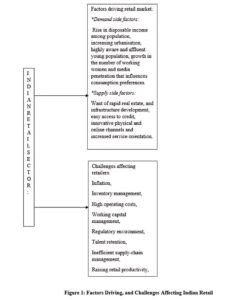
Retailers to be a part of the industry growth could meet the challenges by revamping their operations through an influx of product variety, new working processes, building brands, re-doing supply chain management and exploring new markets. Building ‘Customer Experience’:Social networks, smart phones, tablets, etc. have become an integral part of everyone’s life changing the way one shops, with customers’ looking out for an omni-channel (shopping through various mediums) experience and 24/7 shopping. Earlier, various channels (online, mobile, offline, etc.) were operating in silos.
Today customers are socially aware, tech savvy and yet indecisive on their choice of ‘preferred retailer’, products to be purchased online vis-a-vis in-store, and so on (PWC Global’s Total retail report, 2014). This calls for retailers to exploit market opportunities, work towards customisation (make intelligent usage of analytics to gauge consumers’ preferences), offer transparency and access to information on the availability of stock- all in order to provide a real ‘customer experience’.
Growth of the online market place has facilitated the emergence of a new channel called consumer to consumer that permits consumers to do business with other consumers through a facilitator who provides a market of exchange, for example, eBay, Yahoo auctions, etc. (Anderson and Zahaf, 2009). This study found customers avoid online shopping due to preference for the services provided by brick- and-mortar retailers, those not using the new channel but buying online are comfortable with the hassle-free experience and those who are using the new channel being price sensitive, are able to compensate for any perceived risks by researching more on the products to be bought (Anderson and Zahaf, 2009).
A major driving force behind retail revolution can be attributed to the dynamism and innovative flair for IT usage by today’s customers who are living in a highly digital cultural environment. Such customers prefer a shopping experience that is convenient, efficient with an assurance of speedy delivery of ordered products. Technology has facilitated marketers to develop consumer profiles by evaluating their search and purchasing patterns. However, the real challenge lies in want of proper infrastructure facilities to ensure timely delivery (i. e. speed and convenience) of products to all customers. Further, consumers are displaying multichannel buying behaviour so as to get the benefit of shopping in every place at all times. This implies that all retailers be they online or offline, need to do away with the old boundaries and look towards nterlinking so as to give customers the best of the online and offline retail world as will be discussed in the following section.
4.0 Towards leveraging integrated efforts among retailers
The current retailing scenario is customer driven with every retailer trying to pamper their customers with attractive product/service offerings. These customers, however, do not patronize any format/channel as they seek functional benefits at unorganized outlets and emotional benefits from organized retail stores (Madan and Sharma, 2012) and typically shop at more than one channel (Multichannel strategy, 2013). India Retail Trends (2014) identified decreasing communication costs, rising Broadband PC penetration and increased usage of credit card and debit card as the key enablers fortifying the growth potential of organized retailers and e- tailers. The strengths and challenges faced by different types of retailers are indicated in Table 1. Nevertheless, in the current information rich-age the biggest challenge before all types of retailers is to deliver superior products/services through differentiated experiences that will suit the ever-changing consumer needs and preferences.
The following studies highlight ways on inducing positive retail consumption among customers: Multichannel Strategy (2013) found that multichannel buyers browse the web to gather information on products but prefer to purchase and negotiate returns through any of the channels/outlets. This study opines the need for retailers to maintain the right balance between ‘customer experience’ and ‘contact centre operations’ by using a multichannel strategy that caters to all segments of the changing demographics across all geographies. Retail Leadership Summit (2014) suggests tapping emerging consumer segments through using business models that leverage technology, supply chain innovation and hybrid models adoption that would integrate their online and offline presence and also be able to attract customers from rural, smaller cities and towns.
PwC Global’s Total retail report (2014) found that ‘customer loyalty’ in the true sense develops only when retailers are able to build an element of ‘trust’ that repeatedly attracts customers to their store. The study suggests multichannel and online retailers to leverage their efforts and create business models that would help to expand operations beyond metros, Tier-1, 2 & 3 cities and convert footfalls/browsers to actual consumers. Such moves will facilitate customer’s access to new channels and also enhance retailer’s flexibility in delivering value to them.
Studies (Mishra and Mathew, 2013; and Gehrt, et al, 2012) found that despite the low penetration levels of the internet users, the online market has got tremendous growth potential.
While examining the relationship between shopping orientations and a validated scale of web site attribute importance among Indian online shoppers, Gehrt et al (2012) found the patterns of India’s pioneer two segments: quality at any price, and recreation/reputation, to be similar in terms of internet usage and online shopping. These researchers suggested e- tailers to rely on diffusion of innovation to build up the value appeal. Mishra and Mathew (2013) found that Indian online buyers perceived a very high level of risk/fear on the delivery of goods bought online. However, quality of information, product range and after online sales service were the most preferred website attributes influencing its usage.
Retail Operations Benchmarking and Excellence survey (2014) gave an interesting perspective on the impact of increased access to mobile internet suggesting that with increased access to 3G and 4G mobile internet services in the next five years, m-commerce can expect to gain about 20 percent share of the country’s e-commerce market. Moreover, online retailers are now catering to consumers in more than 3000 postal areas, whereas, even the largest retail store chain (organized retailer) currently covers only around 100 locations in India (ibid, p.3). This is an indication of future growth opportunity with an integrated multichannel approach.
The above discussion advocates leveraging the integrated efforts of unorganized retailers, organized retailers and e- tailers, so as to induce positive retail consumption through a multichannel approach and in the process create a win-win situation for all involved. Keeping in mind the discussions put forth in the paper a framework to this effect has been proposed (illustrated in Figure 2).
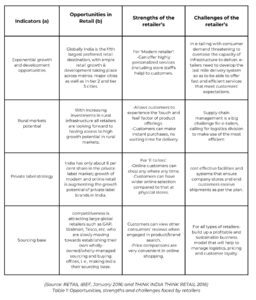
As shown in Figure 2, the Indian retail market faces many challenges (inventory management, inefficient supply chain, etc.) that will impact all retailers and could adversely affect their costs and profits.
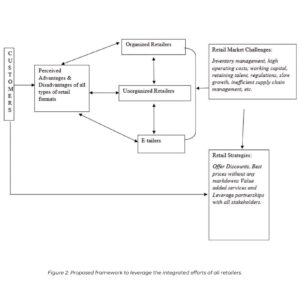
We propose to leverage the integrated efforts of all retailers towards addressing the challenges. Organized retailers, with the help of analytics etc. can identify target customers’ needs, manufacture products, develop interfaces with unorganized retailers (suitably located) and e- tailers (for tech savvy customers), provide them (retailers) the necessary marketing support to display and sell the products to customers through their formats/channels. Today’s consumers do not patronize any single type of retailer. They prefer to weigh the perceived advantages and disadvantages of each format and then make a choice. So, integrated efforts between retailers where each one shares with others valuable insights on the target customers will facilitate cost reduction and efficiency in supply chain management.
Additionally, such benefits can be passed on to buyers through discounted offers. Moreover, such efforts could pave the way to explore retail opportunities through suitable retail strategies in the futureE- commerce leader Amazon India had attempted this when as a pilot study they decided to launch an express delivery platform in partnership with the kirana shops of Bengaluru to cater to the local needs. Of course, only time will tell the outcome of Amazon India’s attempt. Nevertheless, with more in stake for the integrated efforts of online and offline retailers to meet customers’ expectations of fast and efficient delivery of products/services, there are few challenging questions posed on which they need to reflect, and address:
Do the retailers have the bright personnel with the requisite offline & online marketing skills? Have the retailers (offline as well as online) worked out a robust and future-proof data strategy? Have these retailers been able to identify the ‘right marketing mix’ and communications channels for a wider targeted audience?
Conclusion
Competitive business scenario along with growing consumerism requires all retailers to intensify efforts at offering differentiated quality products and services to customers. The evolving Indian retail market is currently characterised by twin growth engines-the economic liberalization coupled with the demographic profiles providing the right impetus for growth. Organized retailers are trying to exploit the market with an influx of new work processes, technologies and modern concepts so as to provide delightful customer experiences. Unorganized retailers are re-doing their in-store ambience, offering credit, etc. to woo customers. E-tailers are offering different categories of products, discounts and the payment on delivery facility to customers.
Technology has impacted the way tech savvy consumers in this information-age interact with different retail channels using the multichannel approach and yet they are not loyal to any retail channel. So, instead of competing with each other the authors of the current study feel that leveraging an interface between all categories of retailers would work for the good of all. In spite of the popularity of e- tailing, customers will continue to shop at physical stores (both organized outlets and the traditional brick and mortar stores) mainly because for customers shopping is a recreational activity. At physical stores they get to touch and feel the products and interacting with the sales personnel provides the necessary social appeal. Realising the importance of e-tailing many of the traditional brick and mortar retailers have attempted to go online either through their websites or by tying up with popular e-tailers such as Snapdeal, Myntra, Jabong, etc. The idea is to use and bring technology to stores, provide multiple interacting points and support to the customer.
Since the customers have experienced the convenience of e-tailing they will expect more and an integrated collaboration amongst all retailers in future can work towards a satisfying customer experience. In view of this a framework is proposed (Figure 2), wherein all- organized and unorganized retailers, as well as e-tailers could leverage an integrated business model so as to be able to deliver quality products/services through a multichannel approach and create ‘delightful customer experiences. This review paper through discussions has communicated on ways through which organized retailers can exploit market opportunities and overcome challenges in the retail market. Additionally, a collaborated interface between organized, unorganized retailers and e-tailers is felt could help leverage positive consumption behaviour among customers and also pave the way towards creating satisfying shopping experiences.
Competitive business scenario along with growing consumerism requires all retailers to intensify efforts at offering differentiated quality products and services to customers. The evolving Indian retail market is currently characterised by twin growth engines-the economic liberalization coupled with the demographic profiles providing the right impetus for growth. Organized retailers are trying to exploit the market with an influx of new work processes, technologies and modern concepts so as to provide delightful customer experiences. Unorganized retailers are re-doing their in-store ambience, offering credit, etc. to woo customers. E-tailers are offering different categories of products, discounts and the payment on delivery facility to customers. Technology has impacted the way tech savvy consumers in this information-age interact with different retail. One limitation of this paper is that categorized as a general review paper, inputs have been drawn from secondary sources such as referred journals, reports and reference books, however, to gather practical insight and gain a better understanding on consumer offline versus online shopping behavior would call for carrying out an empirical survey study.
Such a research study would require researchers to administer questionnaires to customers (both online and offline) that gauge their buying behavior in terms of analyzing attributes that attract them to stores and also determine factors that contribute towards store loyalty. Additionally, although this review paper through discussions has drawn a broad conclusion on the tremendous scope of modern/organized retailing in India, a research study specifically focusing on any product category (say, luxury retailing or perishables like food retailing, etc.) would help to throw up more interesting facts and findings. Such a line of research could be attempted in the future.
E-age has helped to reduce the world to a global stage. Entrepreneurial marketers should examine value added strategies that can initiate cross-border initiatives across markets (Nair, 2016). For this purpose, future researchers could carry out primary empirical studies that will examine real time offline versus online retail buying behaviour in countries across borders. For instance, comparative studies between an emerging economy like India and developed economies like USA and UK will help reveal marked differences existing in online and offline retailing buying behaviour between established and emerging markets. Such studies will also provide perspectives on the scope of growth of the retail market both within the domestic market as well as across global markets.
References
Anderson, J. and Zahaf, M. (2009), Identifying Consumer Behaviour toward Consumer to Consumer E- Commerce: Channel Adoption Barriers and Benefits, International Journal of the Academic Business World, Vol.3, No. 1, pp.1-12.
Browne, G.J., Durrett, J.R and Wetherbe, J.C. (2004), Consumer reactions toward clicks and bricks: investigating buying behaviour on-line and at stores, BEHAVIOUR & INFORMATION TECHNOLOGY, Vol. 23, NO. 4, pp. 237–245.
Byramjee F.D., History of Marketing Thought in the Medieval Indian era- as portrayed by the Arthshastra, CHARM 2005, Available at: faculty.quinnipiac.edu/char m/CHARM%20proceedings/ CHARM20%article%20archiv e%20pdf%20format/Volume%2012%202005/39%20byramjee.pdf (accessed on May 5th 2014).
Dutta, S.S, Nimbekar, A. and Sood, A. (2016), Think India Think Retail 2016, Knight Frank India Pvt. Ltd., Mumbai, available at http://content.knightfrank.c om/research/317/document s/en/india-retail-report- 2646.pdf (accessed on 11 February 2016).
Gehrt, K. C, Rajan, M. N., Shainesh, G., Czerwinski, D., O’Brien, M. (2012), Emergence of online shopping in India: shopping orientation segments, International Journal of Retail & Distribution Management, Vol. 40 No. 10, pp. 742-758.
Global e-tailing 2025, (A study by Deutsche Post DHL), available at http://www.dpdhl.com/cont ent/dam/dpdhl/global_etaili ng_2025/pdf/dpdhl-study- global-e-tailing-2025.pdf (accessed on 11 November 2016)
Goswami, P., and Mishra, M. S., (2009), Would Indian onsumers move from kirana stores to organized retailers when shopping for groceries? Asia Pacific Journal of Marketing and Logistics, Vol. 21 No. 1, pp.127-143.
India’s overall retail market to reach Rs 47 lakh crore by 2016-17: ASSOCHAM I Business Standard, (2074), Available at: http://www.business- standard.com/article/news-cm/india-s-overall-retail- market-to-reach-rs-47- lakh-crore-by-2076-77- assocham- 774027200773_7.html (accessed on 9 May 2014)
Indian Retail the next growth story, (2014), Available at: https://www.kpmg.com/IN/ en/IssuesAndInsights/Artic lesPublications/Document s/BBG-Retail.pdf. (accessed on 13 December 2014).
India Retail Trends 2014, WHITE PAPER-Tata BSS, Available at:http://www.tata- bss.com/pdf/whitepapers/i ndia-retail-trends-2074.pdf. (accessed 76 March 2074) India_Special_Report- India_Online_Retail_Drivin g_Realty_January_2075.pdf, (2075) Available at: http://researchgateway.cbr e.com/Layouts/PublicRepo rtAccess/Default.aspx?PUBID=a7b79737-5eca-4a04-bod5-bf8cacc23f67 (accessed on 30 March, 2015).
Levy, M., Weitz, B.A., Pandit, A., & Beitelspacher, L.S., (2012), Retailing Management, Eighth Edition, New Delhi, McGraw Hill Education (India) Private Limited.
Madan, P., & Sharma, D., (2012), Store Choice and Store Loyalty: An Investigation on Shopper’s Behaviour towards Organized versus Unorganized Retail Stores, International Journal of Business and Management Science, Vol.5, no.2, pp. 119- 135.
Mishra, S., & Mathew, P.M., (2013), Analyzing Perceived Risks and Website attributes in E-Retailing: A Study from India, Journal of Internet Banking and Commerce, vol. 78, no.2, Retrieved 7st March, 2075, from: An open access Internet journal (http://www.arraydev.com/c ommerce/jibc/).
Mohan, G, Sivakumaran, B., Sharma, P. (2013), Impact of Store environment on impulse buying behaviour, European Journal of Marketing, Vol.47 No. 10, pp. 1711-1732.
Multichannel Strategy, June 2013, Available at:https://www.pwc.in/en_IN/in/assets/pdfs/industries/retail-and- consumer/multichannel- strategy.pdf (accessed on 75 March, 2014).
Nair, S. R. (2016), Entrepreneurial co-creation and cross-border manifestos. In Kauffnamm H.R and Shams S. M (eds.) Entrepreneurial Challenges in the 27st Century, pp.200- 227, London: Palgrave Macmillan.
Nimbekar, A., Sood, A., Bachkaniwala, H., Gupta,H.,Dutta, S.S., Rathi, V., and Bangera, Y. (2015), Think India-Think Retail, Available at: Content.knightfrank.com/re search/377/documents/en/in dia-retail-report-2646.pdf (accessed on 30 March, 2015).
PwC Global’s Total retail report (2014), Available at: http://www.rasci.in/downloa ds/2074/Total_Retail_Chang e.pdf (accessed on 73 December, 2014).
Retail IBEF January 2016, Available at: http://www.ibef.org/downlo ad/Retail-January-2076.pdf (accessed on 77 February, 2016)
Retail Industry in India, (2014), Available at: http://www.ibef.org/industr y/retailindiaaspx (accessed on 22 March 2015).
Retail Leadership Summit 2014, Emerging Consumer Segments in India, RAI- KPMG in India Survey (2014), Available at: www.rai.net.in/insights.asp x (accessed on March 24, 2014).
Retail operations benchmarking and excellence survey 2014, The state of multichannel retail, Available at: http://www.tcs.com/SiteCol lectionDocuments/White% 20Papers/Retail- Operations- Benchmarking-Excellence-Survey- 2074_State-of- Multichannel-Retail_02-74-2.pdf (accessed on 76 March 2015).
Sengupta, A., (2008), Emergence of modern Indian retail: an historical perspective, International Journal of Retail and Distribution Management, Vol. 36, No. 9, pp 689-700.

